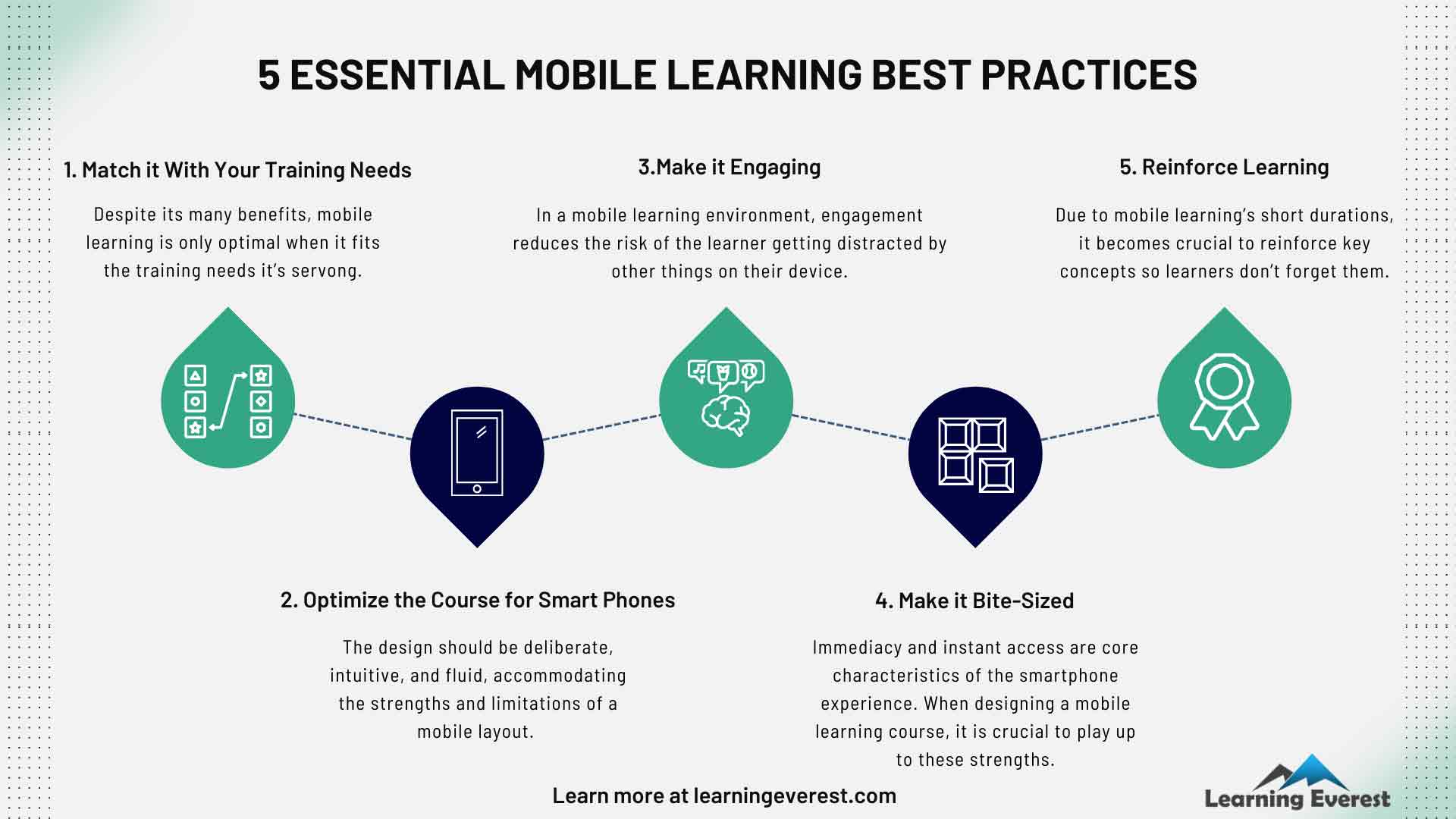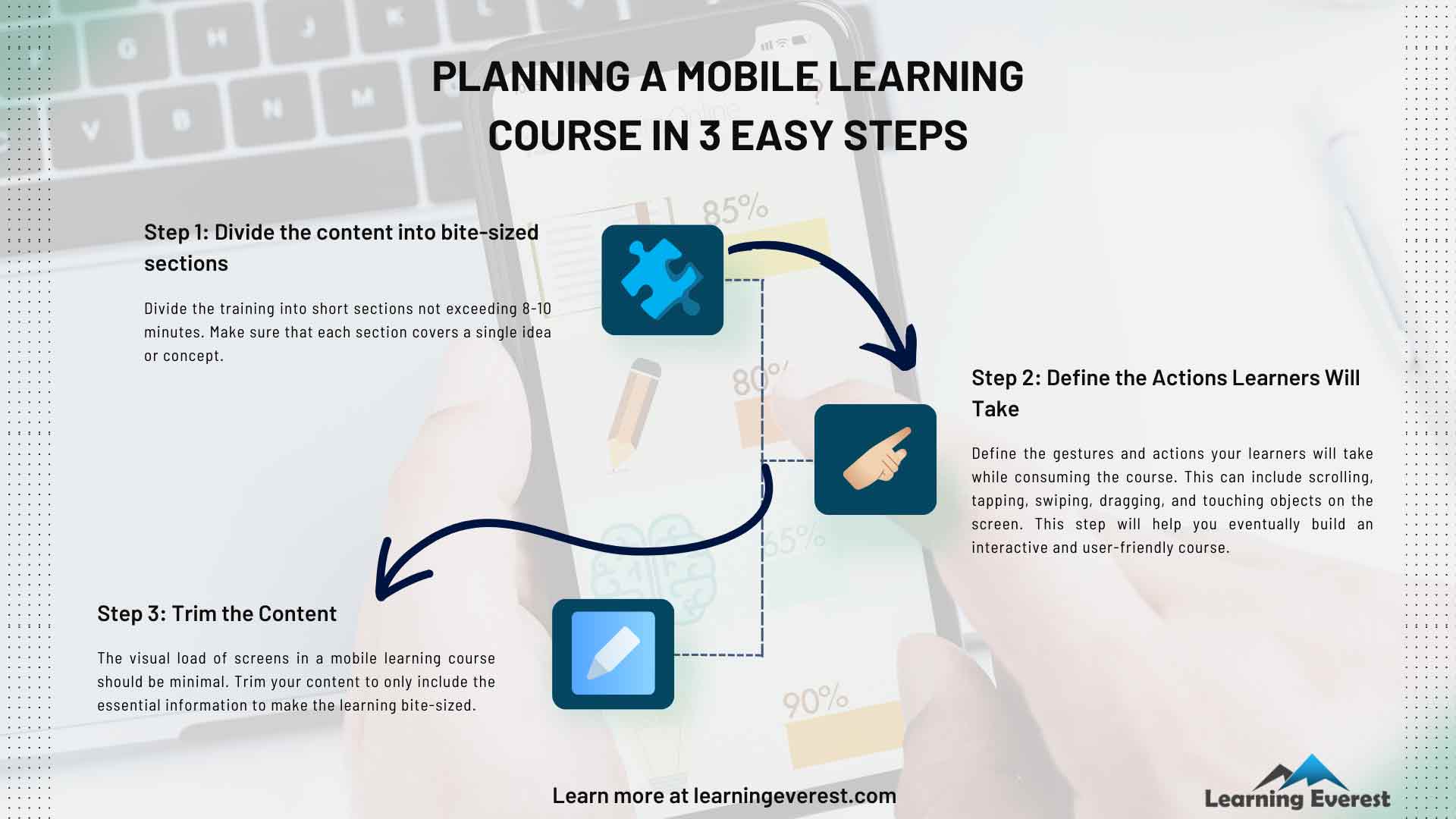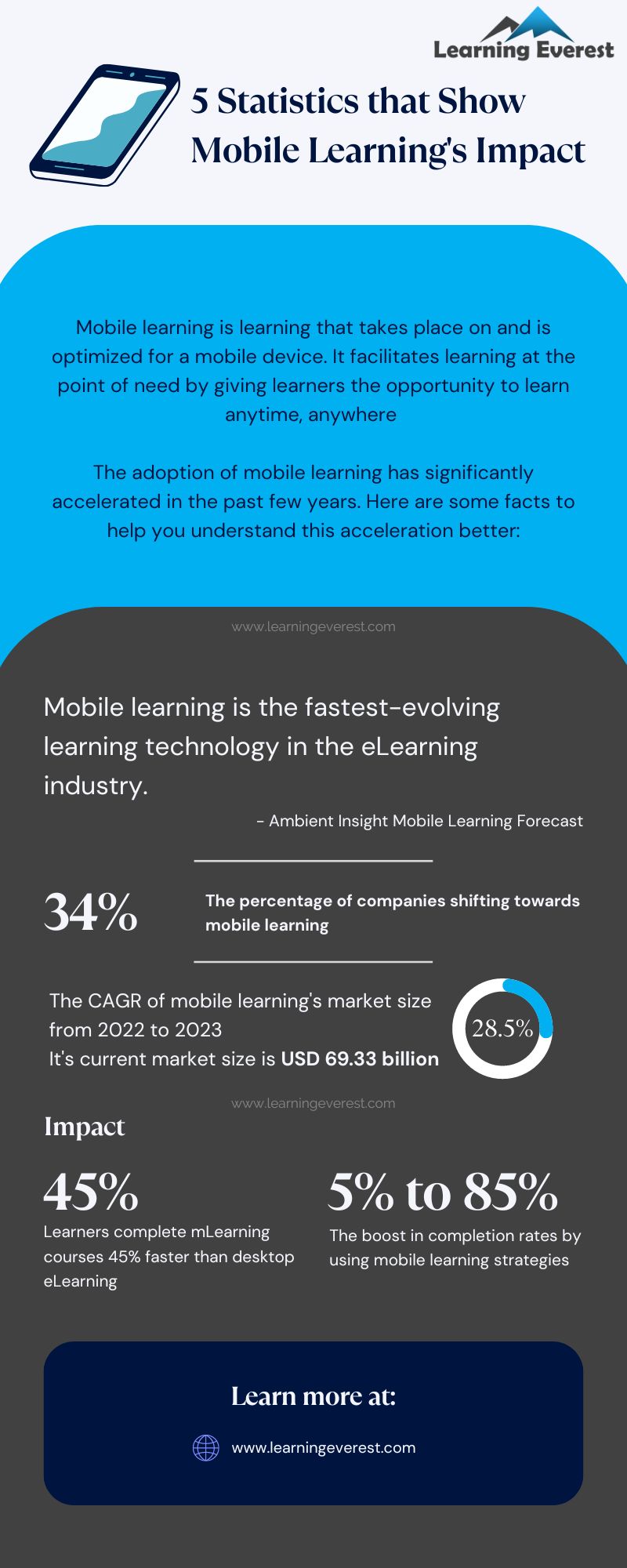The adoption of mobile learning (also known as mLearning) has significantly accelerated in the past few years. For organizations and institutions looking for more effective and hassle-free training strategies, this can be an effective avenue for growth. However, mobile learning as a medium has very specific characteristics and strengths. Thus, to effectively execute a mobile learning strategy, designers and developers need to keep some crucial mobile learning best practices in mind. This article will tell you about 5 mobile learning best practices that should be applied to every mLearning course.
What is Mobile Learning?
As the name suggests, mobile learning is learning that takes place on and is optimized for a mobile device. Mobile learning facilitates learning at the point of need by giving learners the opportunity to learn anytime, anywhere as long as they have a smartphone. This enables flexible learning that takes place in the flow of work, enabling just-in-time learning and greater productivity by minimizing the need to meticulously schedule learning activities. For instance, a study by MindTools found that learners complete mLearning upto 45% faster than desktop eLearning, thereby increasing productivity by upto 43%.
Mobile learning is also well received by learner and increases completion rates. For example, 2U used mobile learning as one of their strategies for increasing completion rates. Through this, they were able to increase completion rates from 5% to a whopping 85%.
Owing to many other such successes, mobile learning’s adoption and prevalence is growing rapidly. In 2019, mobile learning’s market size surpassed USD 20 billion (Source: Global Market Insights). In 2023, it’s market size grew to USD 69.33 billion, with a CAGR of 28.5% from the previous year (Source: The Business Research Company).

5 Essential Mobile Learning Best Practices
Mobile Learning Best Practices
Now that you have a fair idea of mobile learning and the positive pay-off it creates for learners and businesses, let us look at mobile learning best practices. With these strategies, you can elevate your mobile learning courses to be effective and impactful.
Mobile Learning Best Practice #1: Match it with Your Training Needs
Despite its benefits, mobile learning is not an end all solution. The best training strategies depend on the specific training needs that you want to achieve. Thus, mobile learning will be an optimal solution only when it is the correct fit for the goals you have set for your program.
Mobile learning is an excellent option in the following scenarios:
- When the training can be broken down into bite-sized chunks that can be consumed independently
- When you are teaching concepts, skills, or behaviors that are not complex
- When you are teaching simple processes with fixed steps
- When the training material can be taught using rich multimedia resources such as videos and images
- When the training material is not very text heavy
- When you are developing supplementary revision and quiz modules for complex topics
On the other hand, you will want to consider other training options if:
- The training material is extensive and complex
- The training material is largely theoretical
- Effectively teaching the topic requires abstract and critical thinking (such as writing essays, making complex comparisons, understanding and connecting frameworks, etc.)
- The training cannot be delivered in short sessions
- The training requires a fixed learning pathway
To illustrate, here is an example. Bite-sized mobile learning is an excellent training strategy for kitchen staff in a fast-food establishment. However, if your goal is to teach the process for making gourmet chocolates of different types and consistencies to factory employees, a mobile learning approach alone will not cut it.
Thus, the most important mobile learning best practice is to match your training with the training needs. This will save you time and cost, both, in the long and short run.
Mobile Learning Best Practice #2: Optimize the Course for Smartphones
This one might sound like a no-brainer to some, but mobile learning cannot be designed like desktop-based eLearning courses. The design should be deliberate, intuitive, and fluid, accommodating the strengths and limitations of a mobile layout.
In other words, you should adopt a responsive design approach. While rapid authoring tools such as Articulate Storyline 360 can automatically adapt courses into responsive designs, they do not address factors such as the cognitive and visual load of a screen, the use of multimedia elements, screen orientation, navigation options, etc.
Thus, it is suggested to design mobile learning courses individually, instead of adapting content and assets from other courses.
Some general tips to help you implement this mobile learning best practice at all times are:
- Use vertical navigation
- Keep the text to-the-point and succinct, mLearning is not meant for complex deep-dives
- Embed multimedia such as podcasts, audio files, and videos into the course/page for longer content
- Provide the learners with a responsive player for videos where they can switch between portrait and landscape mode
- Create clear visual hierarchies using headings, subheadings, and dividers
- Use accordion interactions
- Try to create sections that require only 3-5 scrolls. If the topic is longer, create multiple click-next sections to accommodate it
Mobile Learning Best Practice #3: Make it Engaging
Engagement is an important predictor of course completion and learning effectiveness, regardless of the learning format. In a mobile learning environment, engagement further reduces the risk of the learner getting distracted by other things on their device. Thus, to ensure your learners make the best out of the course, you will need to keep it engaging.
Some tips to keep learners engaged in a mobile learning course are:
- Keeping the content short and to the point
- Making the most out of navigation and gestures. For example, you can have a pulsating arrow, the option to choose between portrait and landscape mode, carousels, shareable content, etc.
- Making the course material emotionally relevant and relatable for learners with the help of case studies, avatars, mascots, scenarios, stories, and characters
- Using appropriate multimedia that fits a mobile learning material
- Adding a progress bar to give learners a visual cue of their place in the course
Mobile Learning Best Practice #4: Make it Bite-Sized
You may have gathered from the other sections by now that mobile learning takes place in short bursts. In other words, mobile learning is bite-sized and nuggeted. This is because while mobiles are widely used to access information anytime, anywhere, users are not accustomed to learning on it for a long period of time.
Immediacy and instant access are core characteristics of the smartphone experience. Thus, when designing and developing a mobile learning course, it is crucial that you play up to these strengths.
To achieve this, mobile learning should be to the point, giving the learners the most essential information for their learning and trimming away everything else. Additionally, you will need to break down your content into manageable chunks that are optimal for mobile.
For simple training material, these sessions could be as short as 2-5 minutes per topic. For slightly more complex or detailed training material, you could build 8-10 minute long modules. Anything longer than this could run the risk of negatively impacting the user experience and reduce completion rates.
Mobile Learning Best Practice #5: Reinforce Learning
Reinforcing learning is another essential mobile learning best practice. Due to mobile learning’s short durations, it becomes more crucial to reinforce key concepts so learners don’t forget them.
You can do this through recap modules, chapter-end summaries, highlight boxes, dedicated recap modules, or quizzes.
Quantitative quizzes such as MCQs are better suited to mobile learning than qualitative assessments and strategies. As a thumb rule, always provide learners with feedback for knowledge checks and quizzes so they don’t have to infer the reasoning behind what’s correct or incorrect. Feedback also adds another layer of reinforcement to the learning.
Conclusion
Mobile learning is an effective training strategy to opt for when you are looking to train your learners in short and focused bursts. However, mobile learning cannot function on the same designing principles as traditional eLearning courses. Thus, when designing these modules, it is crucial to keep some essential mobile learning best practices in mind to give your learners the most optimal learning experience possible.

Planning a Mobile Learning Course in 3 Easy Steps
Infographic

5 Statistics that Show Mobile Learning’s Impact
Knowledge Check!
Frequently Asked Questions (FAQs)
What are the essential mobile learning best practices?
The 5 essential mobile learning best practices are:
- Match it with your training needs
- Optimize the course for smartphones
- Make it engaging
- Make it bite-sized
- Reinforce learning
What is mobile learning most effective for?
Mobile learning is most effective for training that can be easily broken down into small manageable chunks for bite-sized learning. It is, thus, best suited for simple topics with various sub-parts.
How to optimize mobile learning courses?
There are many ways to optimize mobile learning courses. The general rule of thumb is to honor the medium and deliberately adjust multimedia, layouts, and text to feel intuitive on a mobile device. This includes strategies like embedding elements, vertical navigations, incorporating gestures into interactivities, and managing the cognitive and visual load of the screen.
References
- https://www.thebusinessresearchcompany.com/report/mobile-learning-global-market-report#:~:text=The%20global%20mobile%20learning%20market,least%20in%20the%20short%20term
- https://www.gminsights.com/industry-analysis/mobile-learning-market
- https://www.edsurge.com/news/2019-06-06-moving-from-5-to-85-completion-rates-for-online-courses





